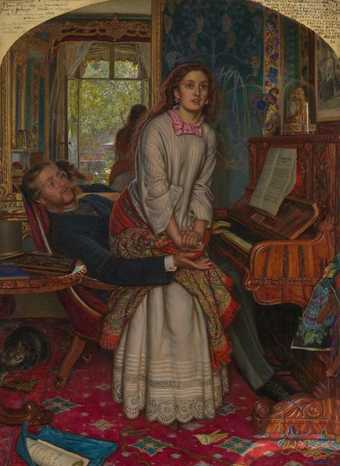
Sir Edward Coley Burne-Jones Love among the Ruins 1870-1873 Private Collection
Introduction
Edward Burne-Jones (1833–1898) was one of the key figures in Victorian art, achieving world-wide fame and recognition during his lifetime. As the last major figure associated with the Pre-Raphaelites, he led the movement into new symbolist directions where the expression of a mood or idea replaced the earlier focus on providing a realistic description of the natural world. Using myths and legends from the past he created dream-worlds of unparalleled beauty, balancing clarity of observation with dramatically original composition.
Initially inspired by the church and by all things medieval, Burne-Jones remained committed to the ideal of beauty throughout his career. For him it represented the antidote to the crude ugliness and rampant materialism he believed was degrading modern Britain. From his studio in Fulham he designed and made artworks in a variety of media: paintings, drawings, stained glass, embroidery, tapestry, furniture and jewellery. Many of the most splendid examples of these works feature in this exhibition, the first major retrospective to be held in London for over forty years. Burne-Jones’s art was intended to uplift and inspire the spectator through its mystery and intricacy of design and execution. It also discloses something of the inner melancholy that lay at the heart of the artist’s vision.
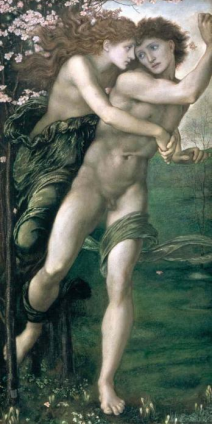
Sir Edward Coley Burne-Jones Phyllis and Demophoön 1870 Birmingham Museums & Art Gallery
Room 1
Apprentice to master: 1856–1870
As an artist Burne-Jones was unusual in having been educated at university rather than art school. Born and raised in industrial Birmingham, he later went to Oxford to study theology. Here he met his lifelong friend and collaborator, William Morris, with whom he developed a love for medieval romance and architecture. In 1856 Burne-Jones decided to abandon his studies and direct his religious enthusiasm towards art. Under the guidance of the artist-poet Dante Gabriel Rossetti he started to make intricate drawings in pen and ink which won him the support of artists and patrons in the Pre-Raphaelite circle.
Burne-Jones’s move into colour was encouraged by his early work in stained glass. As a founder member of the design collective Morris & Co. in 1861, he designed furniture and stained glass for domestic and ecclesiastical settings. This decorative work informed the bold outlines and patches of colour of his early experimental watercolours. In 1864 he was elected to the prestigious but conservative Old Watercolour Society and began exhibiting with them, gradually moving away from Gothic themes to a more classical aesthetic. He resigned in anger six years later following complaints about the male nude figure in Phyllis and Demophoön. By then Burne-Jones had established a reputation as one of the most original and daring artists of his day.

Sir Edward Coley Burne-Jones Margaret Burne-Jones 1885-1886 Private Collection
Room 2
Burne-Jones as a Draughtsman
Drawing was fundamental to Burne-Jones’s practice. ‘To draw was his natural mode of expression,’ a friend observed, ‘line flowed from him almost without volition.’ After moving in 1867 to a house in Fulham known as the Grange, Burne-Jones had enough studio space to embark on a succession of large-scale projects that preoccupied him for the rest of his life. For these he made countless preparatory studies, many of which were considered works of art in their own right.
A close study of Renaissance art, stimulated by four visits to Italy in 1859, 1862, 1871 and 1873, encouraged Burne-Jones’s inventive approach to the body. Male figures tended to be troubled and expressive, while he portrayed women as beautiful, sometimes sinister. Burne-Jones was experimental in his use of media, employing gouache with chalk and later using metallic pigments. For his work in the applied arts he adopted a boldly stylised manner, reserving a more refined approach for figurative studies.
The flip side to Burne-Jones’s obsession with grace and beauty was his fascination with the grotesque, manifested in the comic drawings that betray inner fears and fantasies. In some drawings Burne-Jones appears as the butt of his own humour: falling hopelessly in love, appearing sick and feeble or just overwhelmed by life.
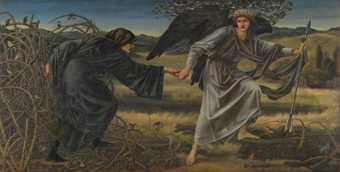
Sir Edward Coley Burne-Jones, Bt
Love and the Pilgrim (1896–7)
Tate
Room 3
exhibition pictures: 1877–1898
Following his resignation from the Watercolour Society in 1870 Burne-Jones experienced a period of liberation which he later described as the ‘seven blissfullest years of work that I have ever had; no fuss, no publicity, no teasing about exhibiting, no getting pictures done against time’. He embarked on a number of paintings that took the London art world by storm when they were exhibited in 1877 at the opening of the Grosvenor Gallery. Established as an alternative to the more conservative Royal Academy, the Grosvenor cultivated artists whose work emphasised sensory expression and poetic feeling above naturalism and narrative. With their unusual extended vertical and horizontal formats, and melancholy subjects in which men are often presented as victims of female power and desire, Burne-Jones’s paintings were controversial and won him immediate fame.
When King Cophetua was shown at the International Exhibition in Paris in 1889, Burne-Jones became known throughout Europe, inspiring symbolist artists from Fernand Khnopff to Picasso. Reproductions of his works promoted his reputation overseas, the absence of colour in the prints reinforcing the remoteness and strangeness of his art.
This room brings together some of the greatest pictures that Burne-Jones exhibited at the Grosvenor and at its successor, the New Gallery, which opened in London in 1888. The later paintings in this section are stark and monochromatic showing just how unwilling the artist was to compromise his vision for commercial purposes.
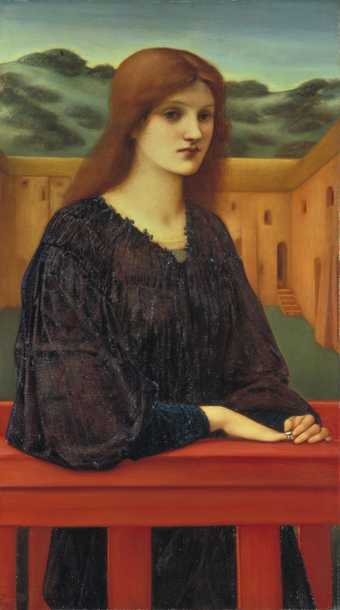
Sir Edward Coley Burne-Jones, Bt
Vespertina Quies (1893)
Tate
Room 4
Portraits
Burne-Jones’s portraits depart from convention in conveying inner feeling above physical likeness or social status. He tended to avoid fashionable society portraiture, preferring to focus on family and friends on whom he could project the pale and enigmatic beauty that became the trademark of his style. Burne-Jones was recorded as saying: ‘My pictures are for the people – my inner life for myself and my friends.’
Familiar faces appear in many of his portraits. These include his long-suffering wife Georgiana with her disquieting penetrating gaze, and his beloved daughter Margaret on the brink of marriage dressed in her favourite blue. Other works show friends such as his devoted patron, William Graham, and his daughter Frances on whom Burne-Jones showered many tokens of affection, several shown in this room.
The few commissioned portraits here were dark and ethereal without props or accessories. Some works such as Flamma Vestalis and Vespertina Quies recall paintings by Renaissance artists such as Leonardo da Vinci and Sandro Botticelli, their titles helping to emphasise the sitter’s spiritual qualities. Although Burne-Jones admired male beauty, he was generally drawn to women whom he imagined as soulful types in tune with the inner workings of his mind.
Room 5
The Series Paintings
Burne-Jones’s preoccupation with myth and legend led to him working with groups and sequences of images. This impulse found full expression in his two great narrative cycles: Perseus and The Briar Rose, both of which have been reassembled for this exhibition.
The Perseus Series
The Perseus series recounts the story of the Greek hero’s quest for Medusa, the Gorgon whose gaze turned men to stone, and his rescue of Andromeda from a sea monster. The commission came in 1875 when the young Conservative politician and future Prime Minister Arthur Balfour approached Burne-Jones about making paintings for the drawing-room of his London residence. He left the choice of subject to the artist.
In telling the story of Perseus, Burne-Jones devised a set of ten subjects to be hung in a band around the room encased within a decorative acanthus border. He also designed panelling and lighting for the space to create an immersive experience. Between 1875 and 1885 he completed the cartoons for the panels, only four of which were eventually worked up into finished oils. The original scheme was also to include four relief panels on oak, of which only one was completed. It is shown here together with a selection of the cartoons and oils to make up the cycle.

Sir Edward Coley Burne-Jones The Rose Bower 1896-1890 The Faringdon Collection Trust
Room 6
The Series Paintings
The Briar Rose
Based on the story of Sleeping Beauty, The Briar Rose consists of four panels on which Burne-Jones worked intermittently between 1874 and 1890. The title derives from the version of the fairy tale published by the brothers Grimm.
All four scenes represent the same moment suspended in time: the prince enters a realm of arrested motion in which figures lie overcome by sleep. As the artist explained: ‘I want it to stop with the princess asleep and to tell no more, to leave all the afterwards to the invention and imagination of people’. The canvases were successfully exhibited at the London art dealers Agnew’s before being shown to a broader audience at Toynbee Hall in the East End, affirming the artist’s belief in art for all. They were subsequently bought by the financier and MP, Alexander Henderson, and installed in the saloon of his country residence, Buscot Park in Oxfordshire. Ten smaller panels were added to link the paintings around the room. Morris provided verses that were lettered beneath the framework of the four paintings. These are repeated here to recreate the ensemble.
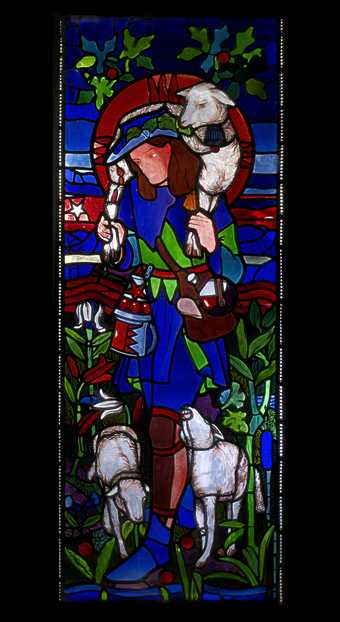
Sir Edward Coley Burne-Jones, Bt. The Good Shepherd 1857-1861 Birmingham Museum & Art Gallery
Room 7
Burne-Jones as Designer
Burne-Jones was in essence a decorative artist. Seeing no distinction between the fine and applied arts he adapted his ideas in different media, designing for stained glass, tapestry, embroidery, furniture, book illustration as well as for painting. In this he was supported by a circle of wealthy collectors for whom Burne-Jones represented the ultimate in artistic taste and refinement.
Designs commissioned by Morris & Co. were his most regular source of income. With the reorganisation of Morris’s company under Morris’s sole direction in 1875, Burne-Jones became its main figure designer, with Morris providing the ornament. Together they developed the Firm’s distinctive compositions combining figures with decorative surrounds for tapestry, embroidery and stained glass.
The majority of Burne-Jones’s designs were for stained glass windows, driven by the market for church decoration throughout Britain and its Empire. It has been estimated that some 660 of his designs were produced as windows by Morris & Co., transmitting to a broad audience around the world Burne-Jones’s vision of ‘heaven beginning six inches over the top of our heads, as it really does’.
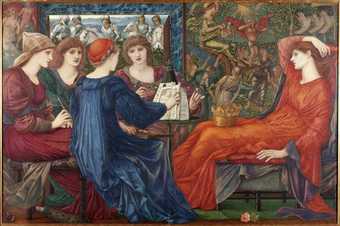
Sir Edward Coley Burne-Jones Laus Veneris1873-1878 Laing Art Gallery, Newcastle upon Tyne


